Finding agates in Alabama can be easier than you think and will feel like a treasure hunt. Agates are special stones that form with bright colors and beautiful bands that look like tiny works of art.
You can find them in rivers streams and gravel beds across the state. Some are hidden in the soil while others shine when the sunlight hits them just right. Searching for agates is fun for kids and adults because it mixes adventure with learning about nature.
You do not need fancy tools to get started just a sharp eye and some curiosity. Walking along a creek or turning over rocks could lead to a surprising find.
If you want to know the best places to look and how to spot these hidden gems keep reading because Alabama has many agates waiting for you to discover and take home.
What is Alabama Agate?
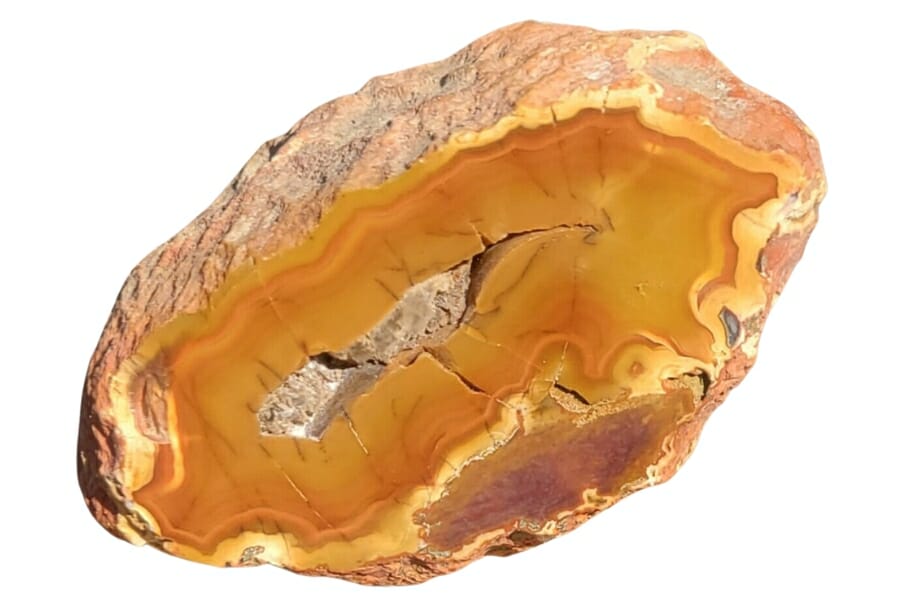
Agates are famous for their bright colors, complex patterns, and mesmerizing clarity. Over millions of years, these semiprecious gemstones form in volcanic rocks, making beautiful works of nature.
These are made when silica-rich fluids, such as basalt or rhyolite, fill holes in volcanic rocks. Over time, these fluids slowly deposit layers of microscopic quartz crystals, giving agates their unique banding and intricate patterns.
The formation process can take millions of years, with each layer representing a different mineral impurity, change in temperature, or other environmental factors.
Each agate has a kaleidoscope of colors ranging from deep reds and blues to warm earth tones. Their smooth, polished surfaces show mesmerizing patterns like banding, fortification, and geode formations.
Find out how much agates are worth with the help of our article.
Blue Lace Agate
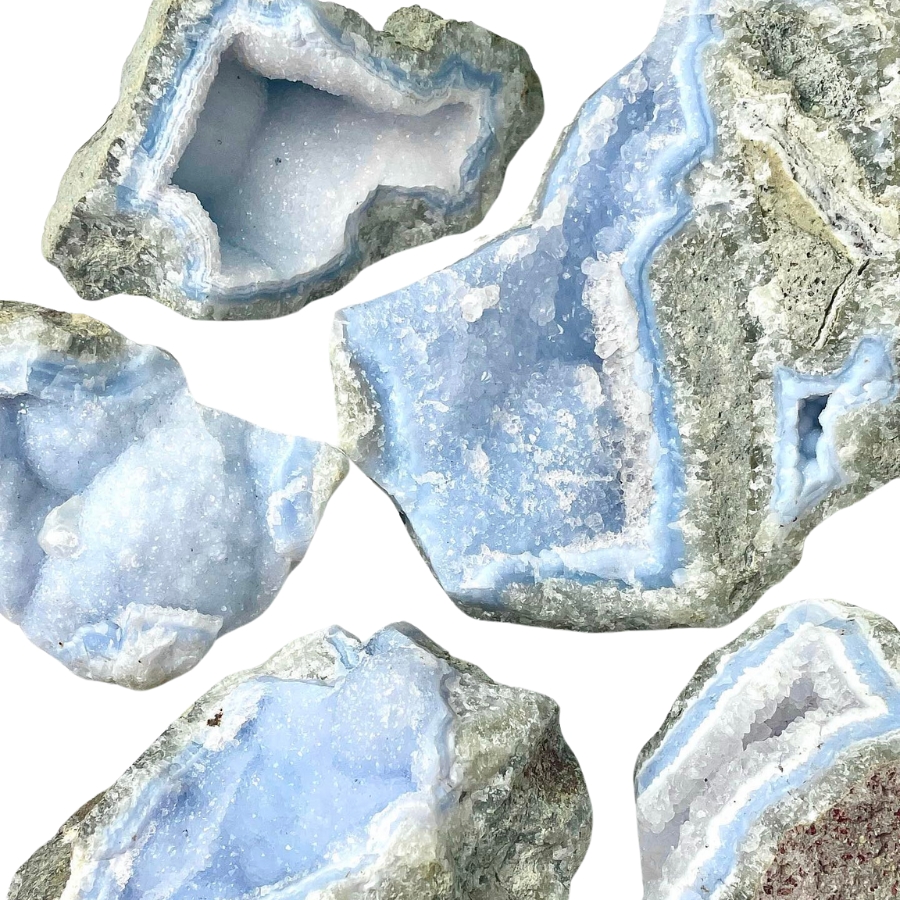
Blue lace agate is like the soft, sky-blue waves with lines that swirl and twist like delicate lace.
Its pattern comes from slow-forming layers of quartz, which create those beautiful, lace-like bands.
The bands of this agate type are often in shades of light blue, white, and sometimes a bit of grey. It’s different from other agates, which usually have more intense colors and stronger patterns.
The value of blue lace agate lies in its soft, tranquil look and the feeling of calm it brings. It’s often used in jewelry or as a decorative stone.
If you want REAL results finding incredible rocks and minerals you need one of these 👇👇👇
Finding the coolest rocks in isn’t luck, it's knowing what to look for. Thousands of your fellow rock hunters are already carrying Rock Chasing field guides. Maybe it's time you joined the community.
Lightweight, mud-proof, and packed with clear photos, it’s become the go-to tool for anyone interested discovering what’s hidden under our red dirt and what they've already found.
Join them, and make your next rockhounding trip actually pay off.
What makes it different:
- 📍 Find and identify 140 incredible crystals, rocks, gemstones, minerals, and geodes across the USA
- 🚙 Field-tested across America's rivers, ranchlands, mountains, and roadcuts
- 📘 Heavy duty laminated pages resist dust, sweat, and water
- 🧠 Zero fluff — just clear visuals and straight-to-the-point info
- ⭐ Rated 4.8★ by real collectors who actually use it in the field
Moss Agate
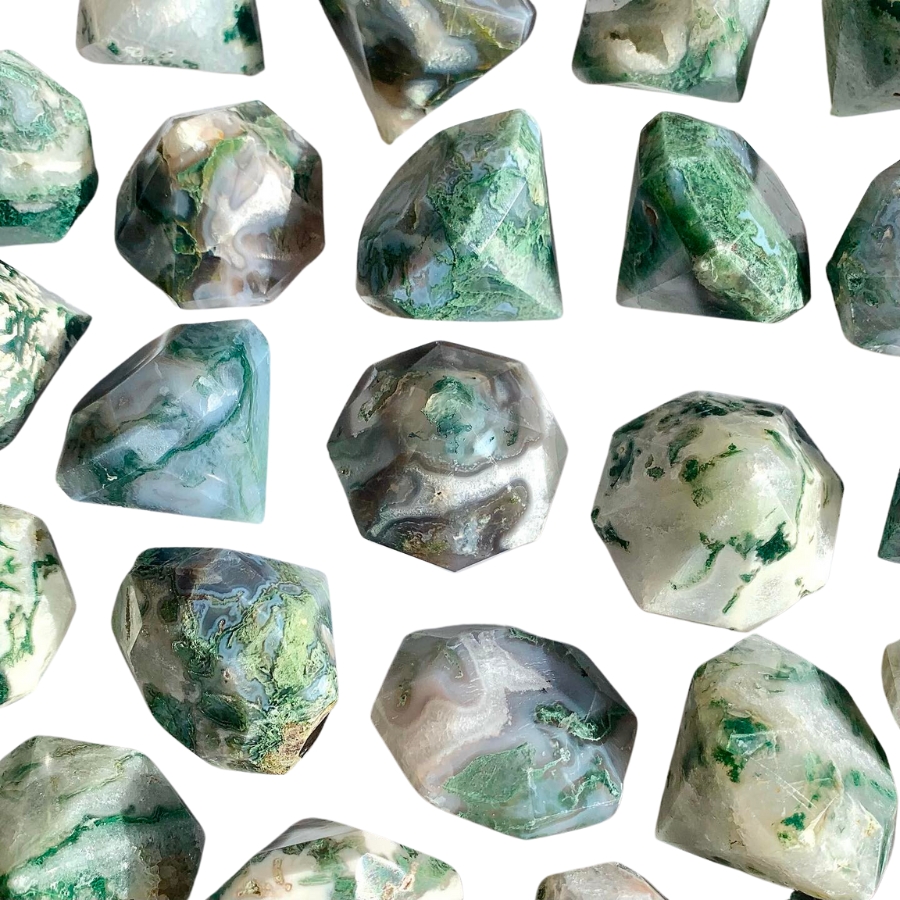
Instead of having the typical banding for which the different types of agates are known, moss agate has green inclusions that look like moss or trees.
These green patterns aren’t real plant material, though. They’re minerals like chlorite or iron oxide.
In some cultures, this type of agate is known as the “gardener’s stone” because of its green, plant-like appearance. It’s believed to help plants grow.
The price of moss agate can vary. It’s often quite affordable, but the more distinct and picturesque the green patterns, the more it might cost.
Fire Agate
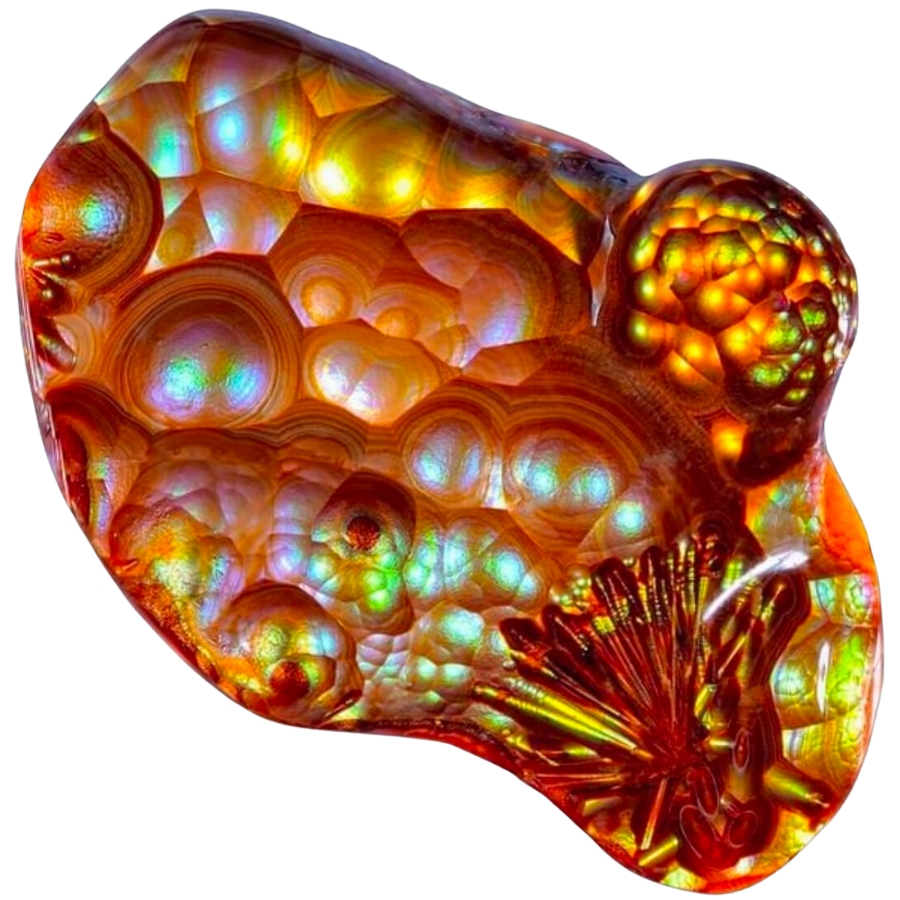
Fire agate is known for its incredible colors and the way it sparkles like fire. It’s got layers of silica and iron oxide that reflect light, creating a fiery effect.
When you look at fire agate, it’s like seeing flames trapped inside. Its colors can range from reds and oranges to greens and golds, all shimmering under the surface.
You might be wondering, “What is fire agate worth?” Well, its value comes from its rare beauty. The more color and sparkle, the more valuable the stone is.
Its fiery iridescence and lively play of color are used in jewelry pieces that are meant to stand out.
Dendritic Agate
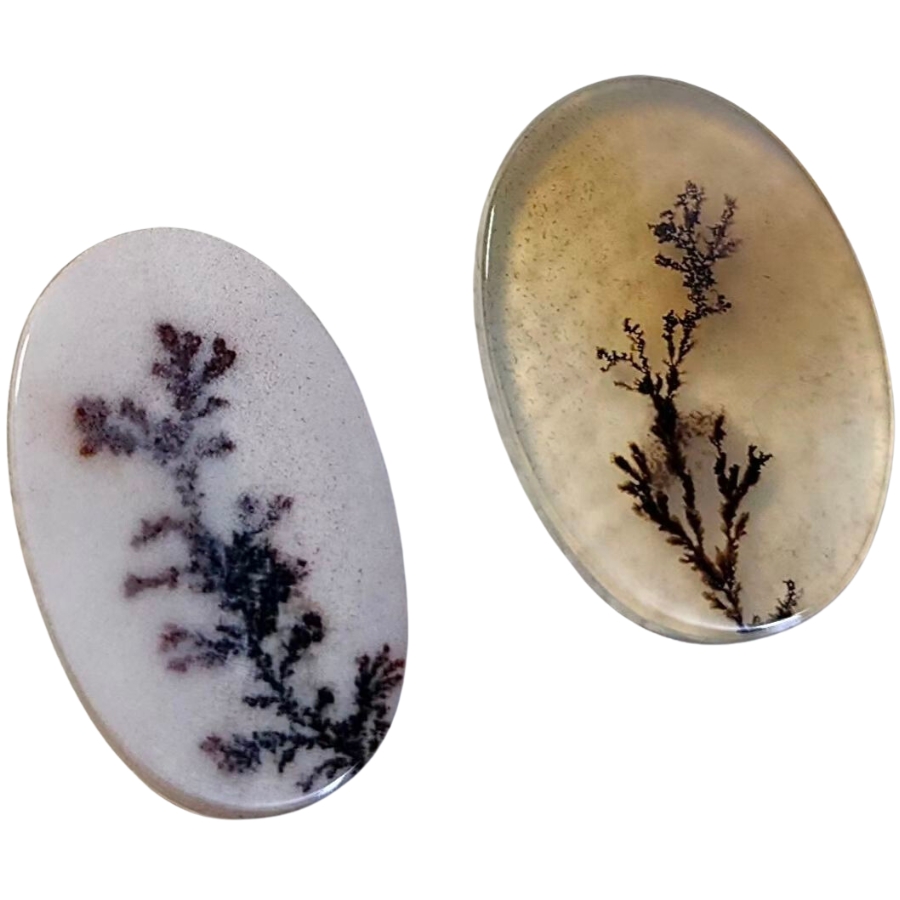
Dendritic agate is known for patterns that look like tiny trees or shrubs. Like moss agate, these patterns aren’t actual plants. They’re made of minerals, mostly manganese or iron oxides.
When you look at a dendritic agate, it’s like peering into a miniature forest or a frosty winter landscape.
The base of the stone is usually translucent to opaque, and the “dendrites”— those tree-like patterns— are often black or brown.
When it comes to how much dendritic agate is worth, it can vary. The more detailed and distinct the patterns are, the more it’s usually valued.
In some cultures, dendritic agate is believed to bring fullness and richness to life.
Crazy Lace Agate
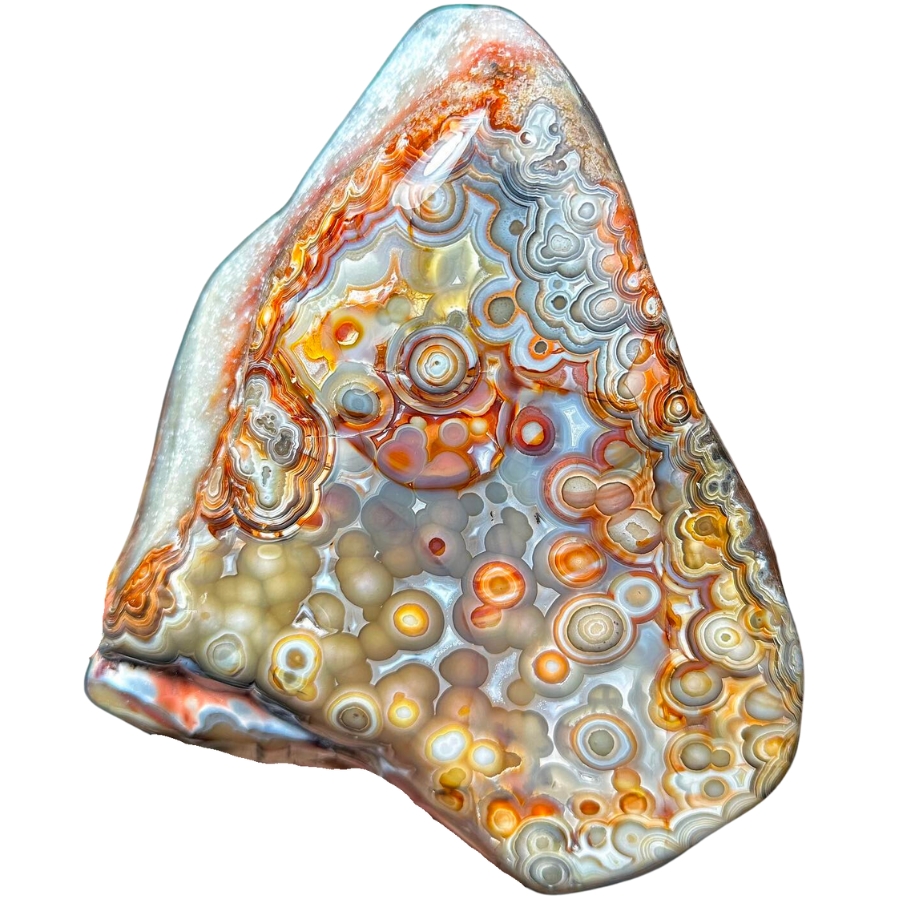
Crazy lace agate is like a party in a rock! It’s got swirls, circles, and all sorts of wild patterns dancing across it.
Its colors can be a mix of red, orange, yellow, and brown, and sometimes even a bit of gray or white.
What makes crazy lace agate stand out is its vibrant and complex patterns. No two pieces are the same. This distinctiveness is a big reason why it’s so valued.
Despite its wild and ‘crazy’ appearance, it’s sometimes called the “Laughter Stone” or “Happy Lace” because of the joy and positive vibes it’s believed to bring.
Laguna Agate

Laguna agate has incredibly sharp and fine banding. It has layers of red, orange, pink, yellow, and sometimes even purple and white all stacked in neat, tight bands.
These bands can form eye-catching patterns, like swirls, loops, and even landscapes.
The different colors of its bands come from various minerals present in the water at the time of its formation.
Laguna agate is considered one of the finest agates in the world due to its exceptional banding. This high regard among agate varieties makes it a prized possession for collectors.
Condor Agate

Condor agate is a real standout. It’s known for its bright, vivid colors and complex patterns.
It has reds, oranges, yellows, and sometimes even blues and greens all swirling together. These colors form in bands or in more random, artistic patterns.
The intensity and variety of its colors is what makes condor agate so special. It’s often used by artists and craftsmen who want to make a statement with their work.
Condor agate’s bold colors and patterns can turn a simple piece of jewelry or art into something really eye-catching.
Fortification Agate (Banded Agate)
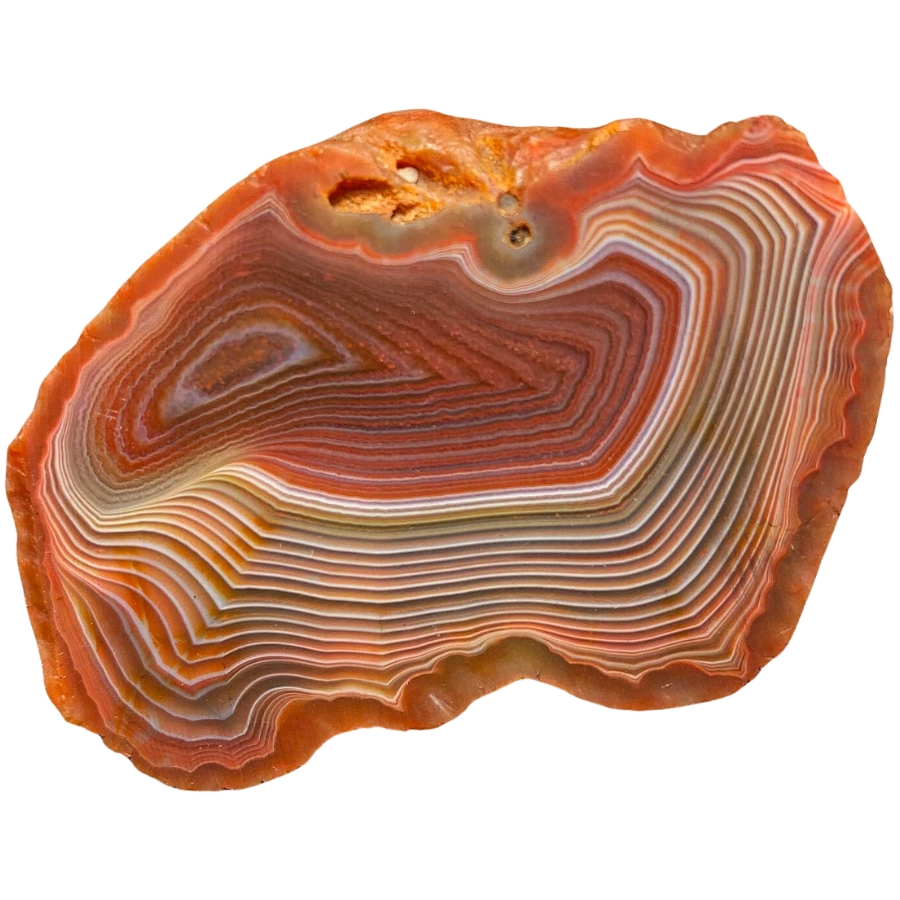
Fortification agate gets its name because the patterns inside it look like the aerial view of a fortified city.
Imagine seeing bands of color forming shapes that look like walls, with sharp angles and curves. They are usually in different colors, making each layer stand out.
If fortification agate is valuable, it’s because of its distinct patterns and colors. Its unique look makes it sought after for jewelry and as a collector’s item.
The clearer and more defined the patterns, the more valuable the stone can be. Some people also believe it can help with relaxation and calmness.
Iris Agate
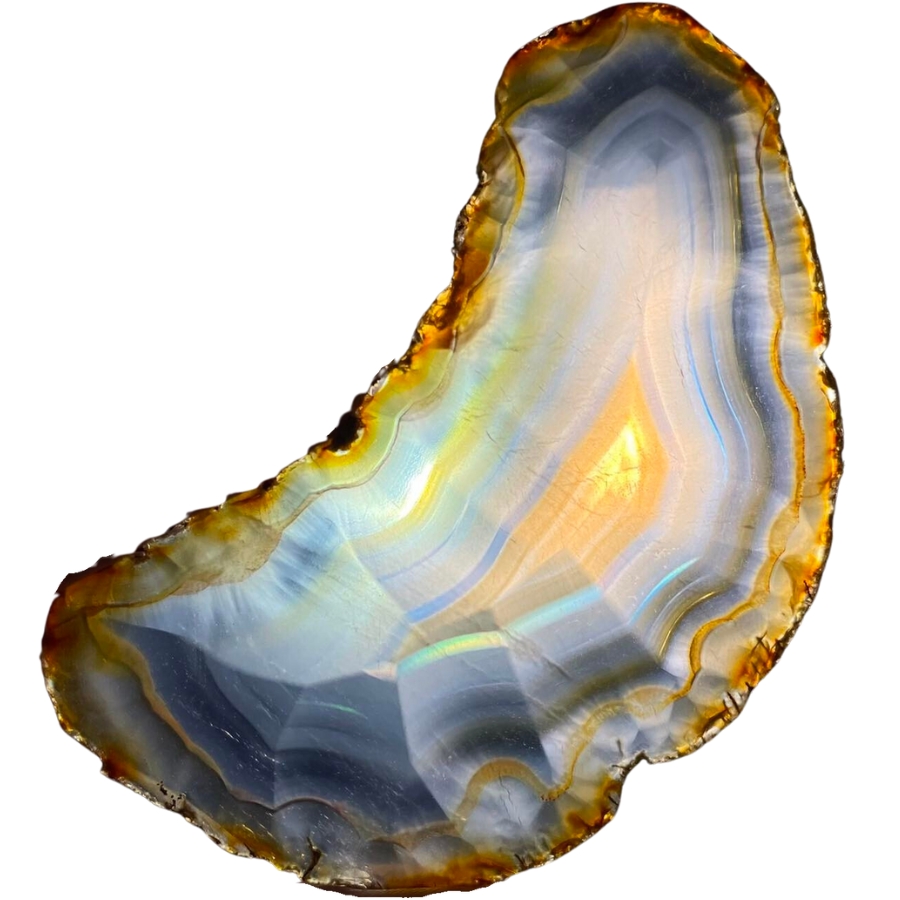
Iris agate looks like a regular agate at first, but when you hold it up to the light, something amazing happens. It shows all these rainbow colors, like light passing through a prism.
This is because it has very thin layers of silica, and when light hits these layers, it splits into all the colors of the rainbow.
The formation of iris agate is similar to other agates, but its layers are super thin, which is what creates the rainbow effect.
The value of iris agate comes from its unique ability to show these colors. In the past, people even used to think it had magical properties because of the way it showed colors. They saw it as a stone of good luck and wonder.
Plume Agate
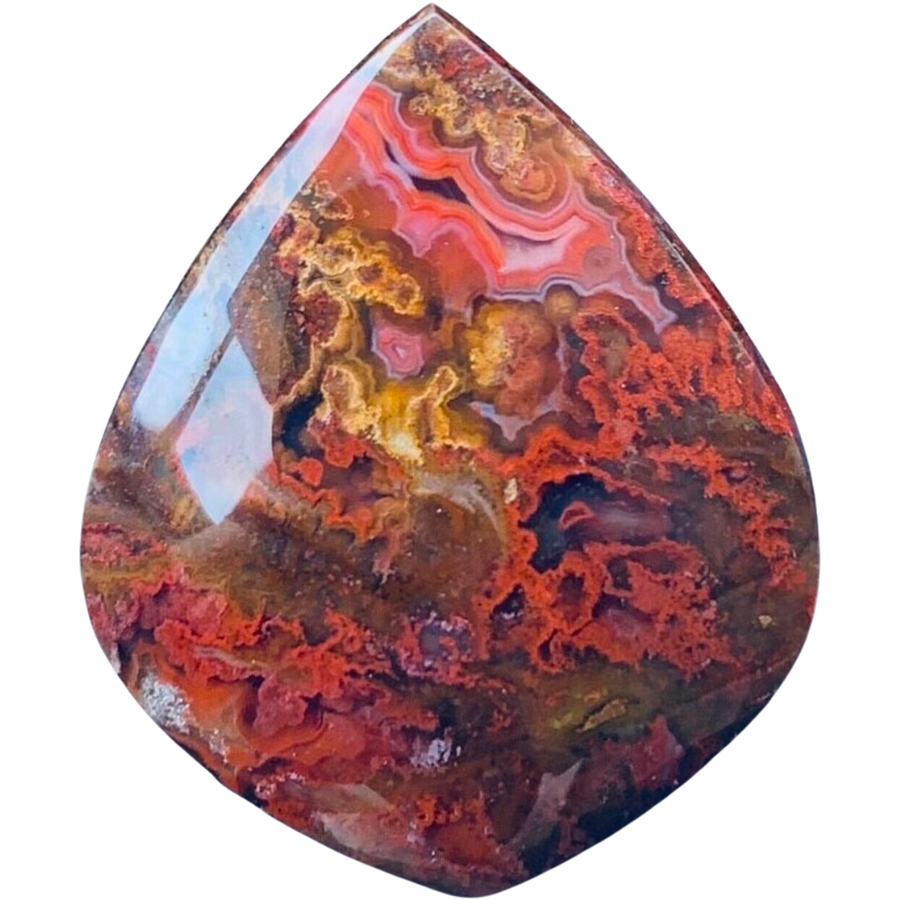
Plume agate gets its name from its patterns that look like soft, feathery plumes. These plumes can be in all sorts of colors: red, black, green, or yellow, set against a translucent or opaque background.
The way these plumes seem to float in the stone makes it look like a frozen underwater scene or like feathers caught in a breeze.
The plumes are made of minerals like manganese or iron oxide, which get trapped in the silica during the agate’s formation and create the feathery patterns.
The price of plume agate can vary depending on how clear and intricate the patterns are. The more detailed and colorful the plumes, the more the stone is usually worth.
Picture Agate (Scenic Agate)
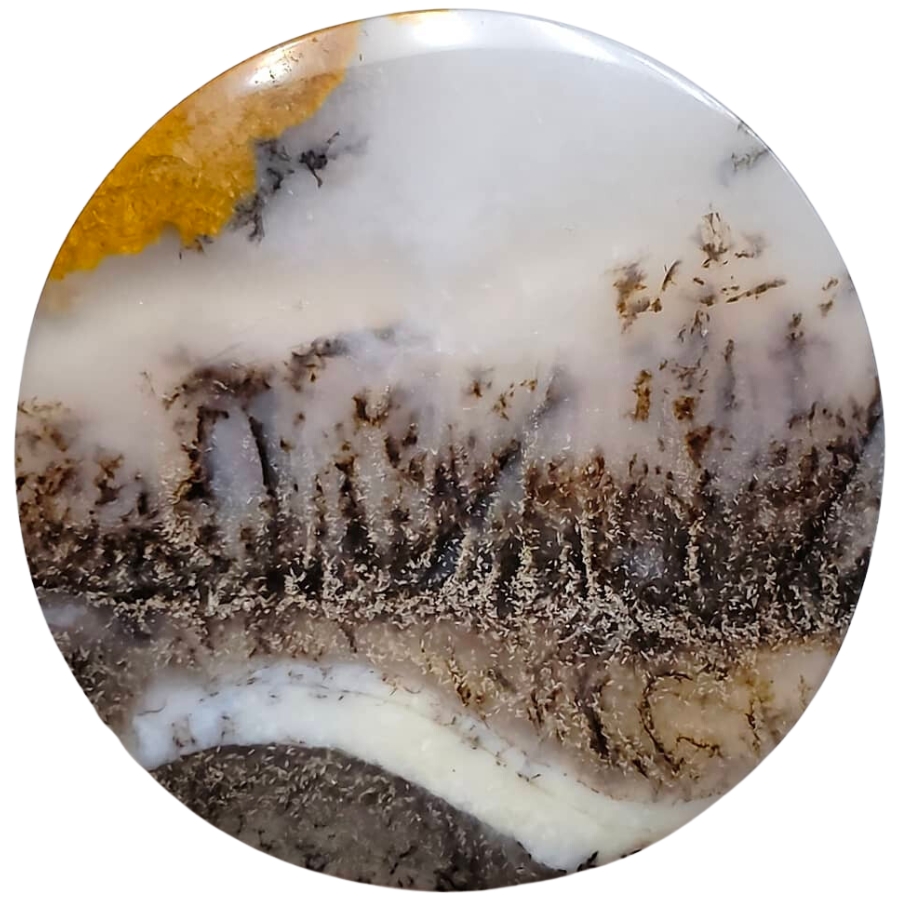
Picture agate is like a snapshot of nature captured in stone because it looks like it has pictures or scenes right inside it.
These “pictures” are actually natural patterns that resemble landscapes, mountains, trees, or even skies. They are usually in different shades of brown, white, and gray against a more translucent background.
The different patterns in picture agate or what’s also called scenic agate are made by various minerals in the water filled with silica that forms it.
If you’re thinking, “What is picture agate worth?“, its value comes from how distinct, clear, and detailed the natural “pictures” are.
Turritella Agate
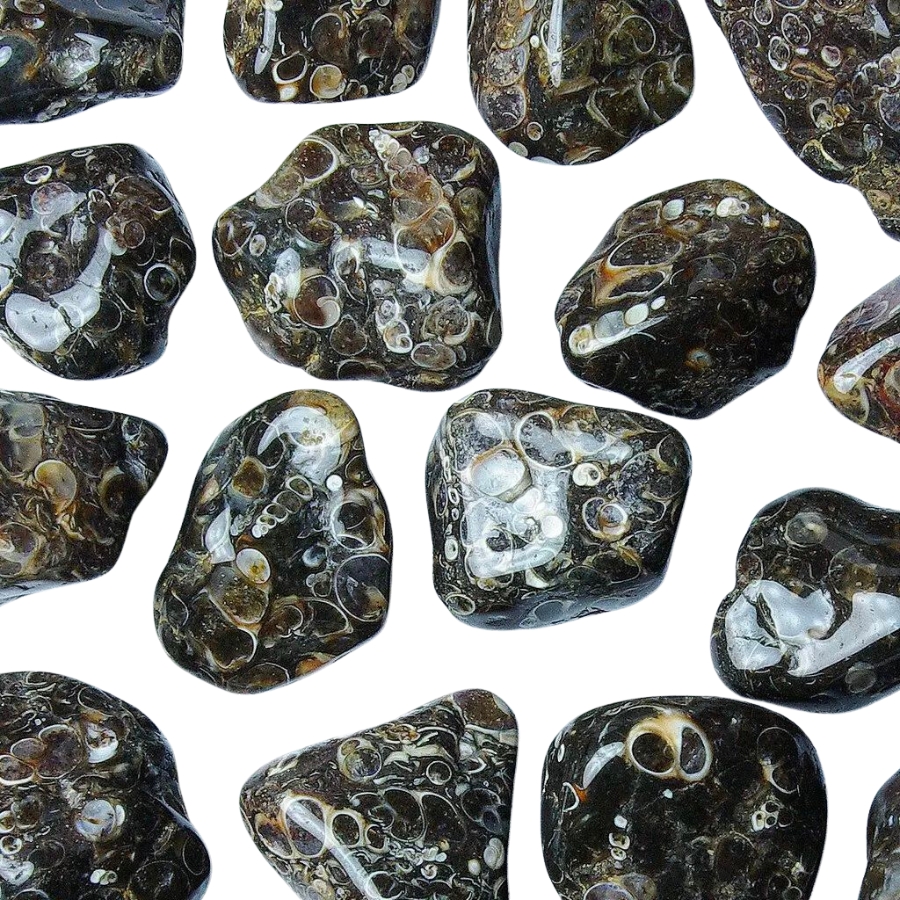
Turritella agate is not your typical agate because it’s full of fossilized snail shells! The shells belong to a creature called Turritella, a type of sea snail.
These shells are tightly packed and create a pattern that looks like a bunch of tiny, swirling towers. The background of the agate is usually a dark, earthy color, which makes the white or cream-colored snail shells really pop.
Over millions of years, these snail shells got buried in sediment and eventually became fossilized. As time went on, silica-rich water flowed through the sediment, turning it into the agate we see today.
The value of turritella agate comes from its unique blend of geology and history. More than a pretty stone, it’s a piece of ancient life preserved in rock.
Fairburn Agate
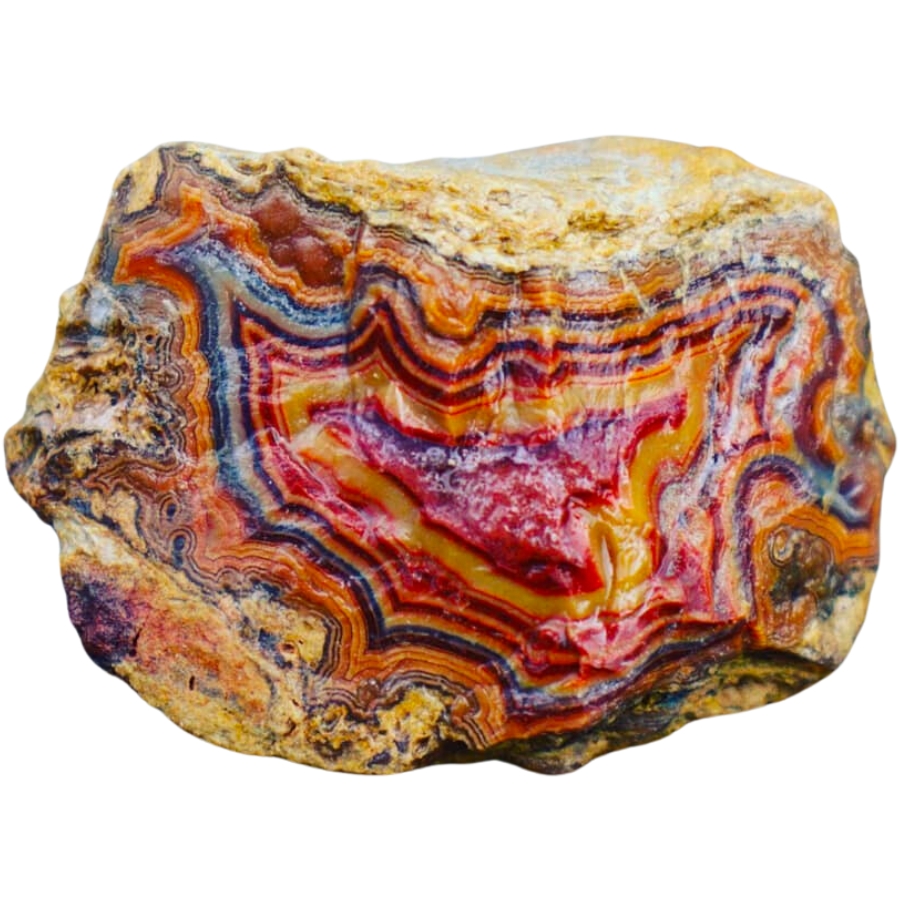
Known for its intricate patterns and bold colors, Fairburn agate is another fascinating type of agate. It usually has bands and swirls of different colors like red, yellow, orange, brown, and sometimes even pink or purple.
What’s special about these patterns is they often look like they’re in layers, creating a 3D effect. It’s like looking at a landscape made of stone.
It’s named after a place called Fairburn in South Dakota. This gives a clue about where it was first discovered.
People value Fairburn agate for the skill it takes to cut and polish it, which makes the patterns and colors really stand out.
Sagenite Agate
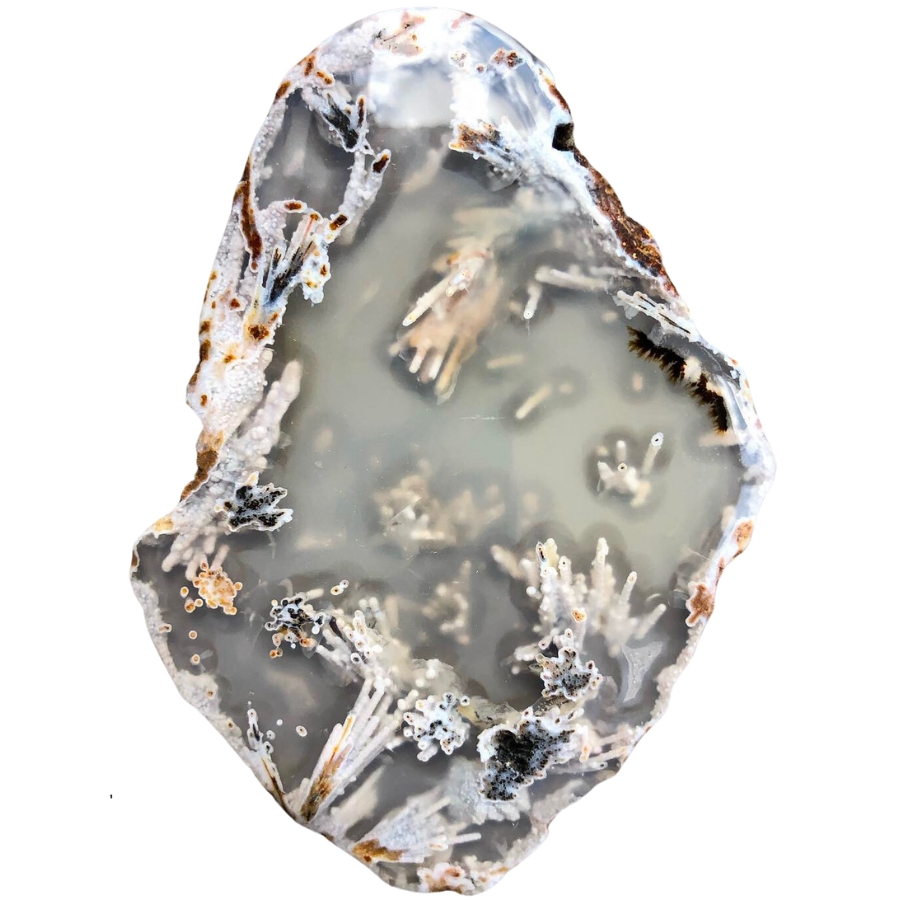
Sagenite agate has needle-like inclusions that look like tiny sprays of crystals inside it. They can be gold, silver, black, or even green, and they spread out in all directions, creating an amazing pattern.
The base of the agate is usually translucent, which lets you see these intricate needle patterns clearly.
These patterns are actually other minerals, like rutile or goethite, that get trapped inside the forming agate. These minerals grow in a crystal shape, looking like needles or hair.
Sagenite agate is often used in jewelry and other decorative items, with some people thinking that its needle patterns look like fireworks or starbursts.
Tree Agate

Tree agate, as its name suggests, looks like it’s got tiny trees or branches inside it. These tree-like patterns are usually green and spread out against a white or light gray background.
The green patterns aren’t actual trees, though. They’re made of minerals like chlorite or manganese.
Each piece of tree agate is different. You won’t find two that are exactly t
The key factors in our recommendations are:
- The deep experience and understanding of our team about the area
- Recommendations from local groups and clubs
- How easy it is to get the a particular location
- Safety and potential hazards when collecting
- Weighing private and public locations
- The ability for both experienced and novice agate enthusiasts to find great samples
With these factors in mind we’ve been able to put together a fantastic list that just about anyone can use!
Kids. Beginners. Pros. Doesn’t matter. This book has become the go-to because it works for everyone.
Magy put it bluntly: “Identify rocks, crystals and minerals is so easy now!”
That’s not by accident, the photos are crisp, the callouts are simple, and the design is rugged enough to throw in a backpack without worrying. Whether it’s your first geode or your hundredth, this guide keeps the fun part simple: finding more treasures.
The Best Spots To Find Agates in Alabama
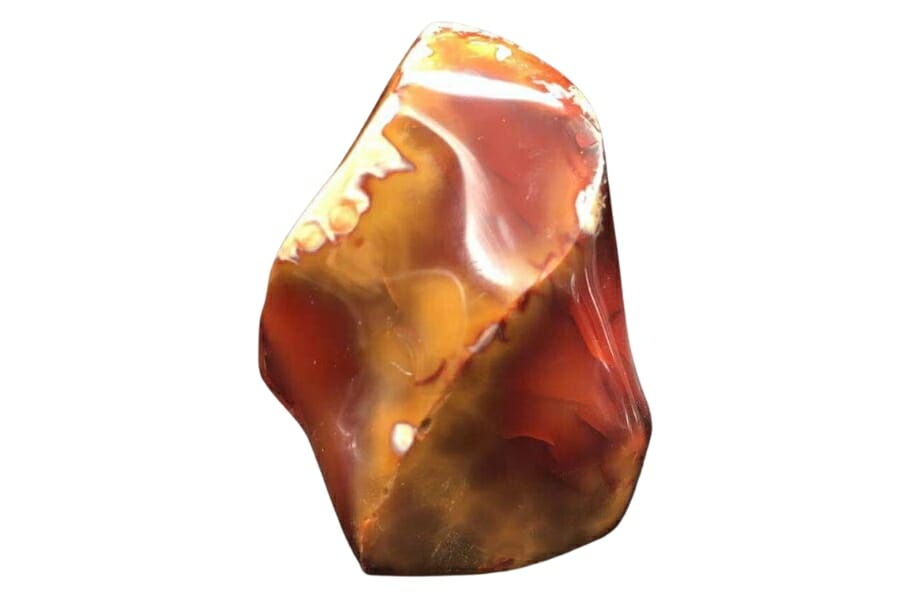
Here are a few places in the state where you can find agates. Even though there are a lot of excellent places to find gems in Alabama, you can’t find agates in all of them.
Always Confirm Access and Collection Rules!
Before heading out to any of the locations on our list you need to confirm access requirements and collection rules for both public and private locations directly with the location. We haven’t personally verified every location and the access requirements and collection rules often change without notice.
Many of the locations we mention will not allow collecting but are still great places for those who love to find beautiful rocks and minerals in the wild without keeping them. We also can’t guarantee you will find anything in these locations since they are constantly changing.
Always get updated information directly from the source ahead of time to ensure responsible rockhounding. If you want even more current options it’s always a good idea to contact local rock and mineral clubs and groups
Bingham Mountain
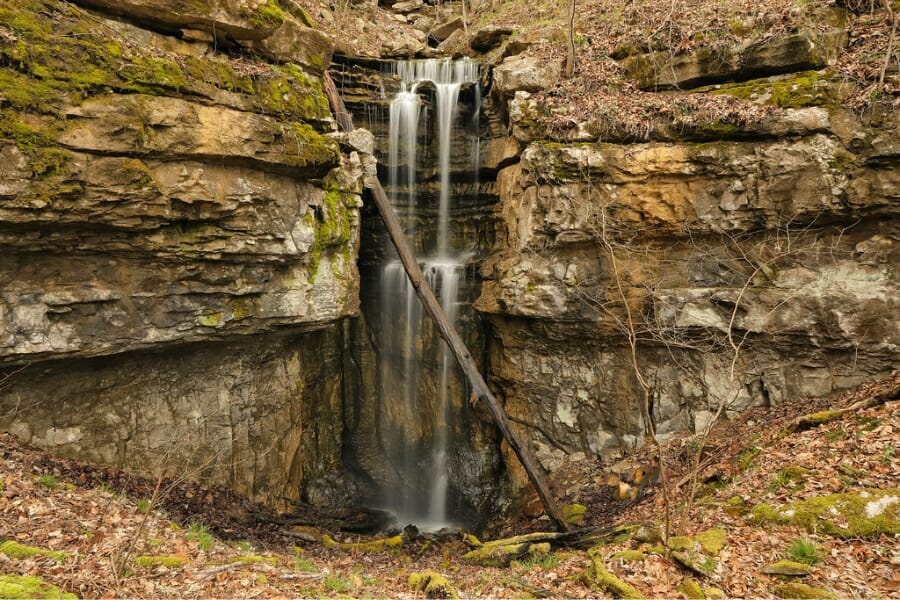
As a part of the Appalachian Plateau, Bingham Mountain has a varied landscape with rolling hills, rocky outcrops, and exposed bedrock. This gives you plenty of chances to find hidden treasures.
The mountain has volcanic rocks, like basalt and rhyolite, known to have agate formations. Geological processes have been going on for millions of years in these volcanic rocks, making holes and cracks where agates can form.
The presence of these rocks with agates and how nature erodes have made agates of different colors, patterns, and sizes more visible.
Before you bring your agate crystals back home from Alabama, make sure you know the most current state collecting rules.
Where we found agates at Bingham Mountain
Agates often end up in stream beds after being washed down from mountain slopes. It can sometimes be found along the banks or in the gravel bars of streams that flow through Bingham Mountain, especially after it rains or erodes.
There are gravel pits all over Bingham Mountain where agates may also be found on the surface or mixed in with the gravel. These pits are worth looking into because you can sift through the loose dirt and find agate pieces.
Cedar Bluff
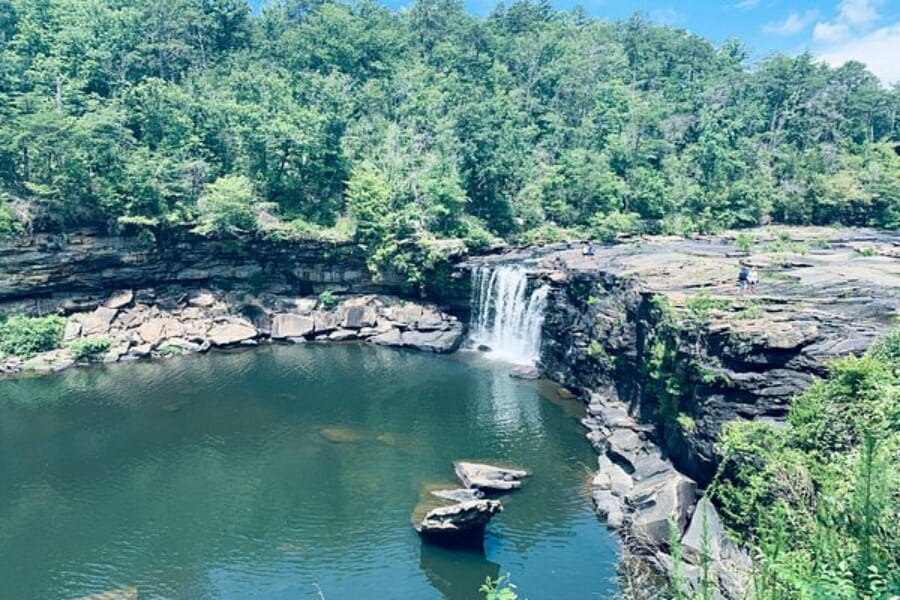
Known for its diverse geological formations and scenic beauty, Cedar Bluff has gained a reputation as a favorable spot to search for agates. Nestled along the banks of the picturesque Weiss Lake, this area presents a unique combination of geological features that make it a promising destination for agate hunting.
The area has a lot of sedimentary rocks, especially chert and flint, which are known to be places where agates form. Geological processes have happened to these rocks over long periods, making holes and pockets where agates can grow.
Where we found agates in Cedar Bluff
Agates can be found in several places that are easy to get to in Cedar Bluff. If you look along the shores of Weiss Lake, especially after high water flow or storms, you might find pieces of agate that have been washed up.
You can also find them in gravel bars and on the exposed banks of riverbeds and tributaries. If you want to look for agates in Cedar Bluff, you must have the proper permissions and follow any rules or regulations.
Paint Rock Valley
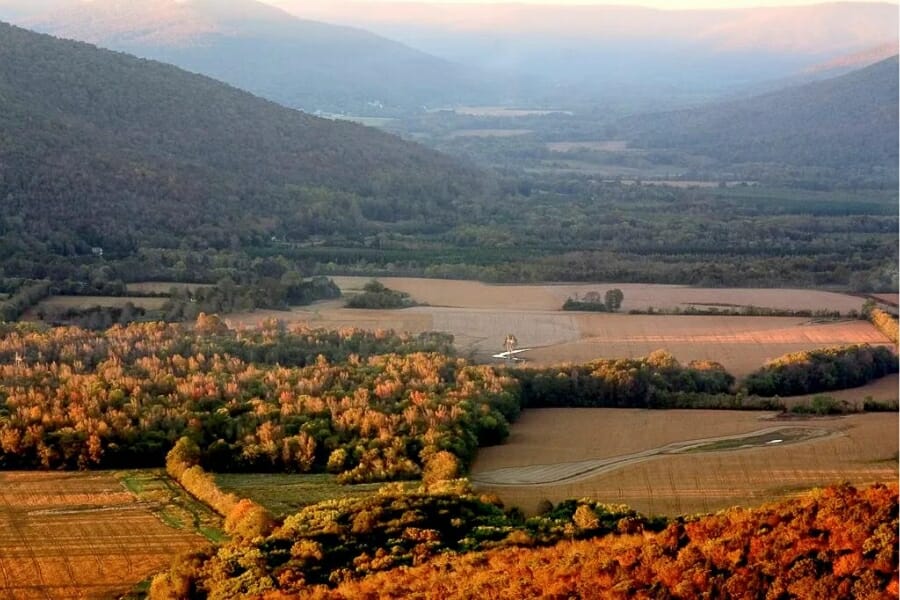
Paint Rock Valley has a unique blend of natural landscapes and geological formations, making it a great place to look for agates. It has a lot of different types of land and a lot of mineral deposits, which make it an excellent place for people who like to look for rocks and agates.
It’s an excellent place to look for agates because of how it was formed. In this area, sedimentary rocks, like limestone and shale, have been changed by geological processes over millions of years.
Where we found agates in the Paint Rock Valley
If you look in the Paint Rock Valley creek beds, especially those that run through the valley, you might find agate. Agates can also be found in the geological layers of exposed rock faces, cliffs, and road cuts in the valley.
Tombigbee River
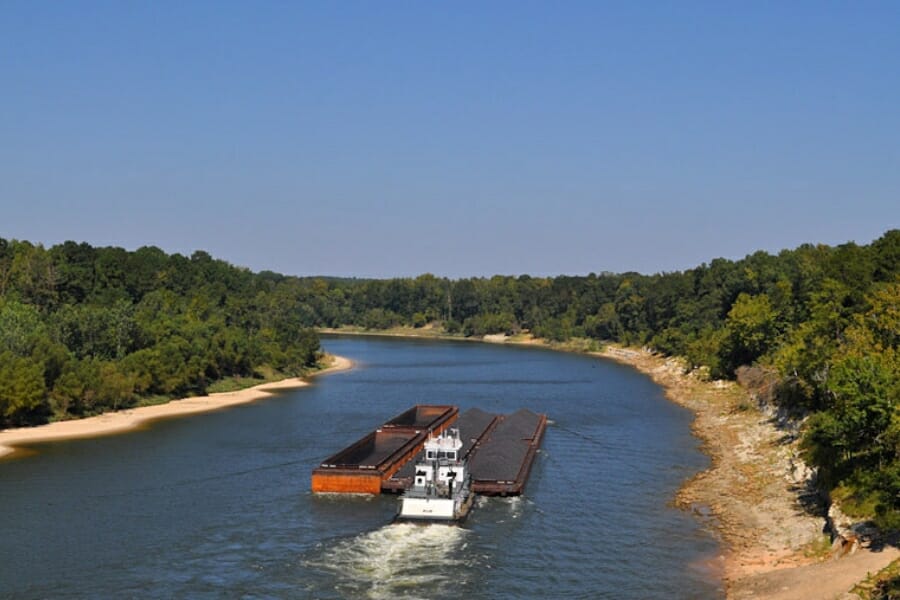
As a significant river in the state, the Tombigbee River flows through many different rock types, making it a great place to look for agates. Its solid currents and natural erosion have exposed agate-bearing rocks along its banks and made it possible to find agates there.
Geologically, the area around the Tombigbee River is a good place for agates to form. The river flows through different kinds of rocks, such as volcanic and sedimentary formations. These rocks can have holes and cracks perfect for agates to grow in.
Where we found agates in Tombigbee River
Agates are often found in gravel bars along a river. These areas are made of sand and rocks pushed downriver by water flow. You might find agate pieces if you look around and sift through the gravel on these bars.
Agate hunting can also be successful on the exposed parts of riverbanks, mainly where erosion occurs. Agates can be found on the ground or partially buried in the dirt. Pay attention to places where the river has cut into the banks or built up small hills.
Warrior River
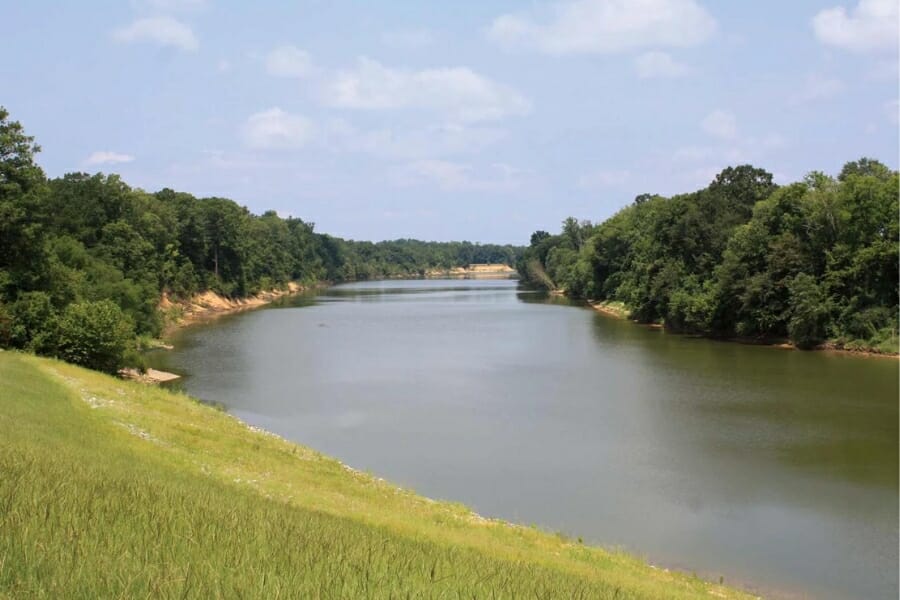
The Warrior River runs through Alabama and is an excellent place for people who like to hunt for agates. This beautiful river flows through many types of rocks and riverbeds, including sedimentary rocks and old riverbeds that can have agate deposits.
Agates are carried downriver by the river’s flow, where they can be found on gravel bars, sandbanks, and exposed parts of riverbanks. These places are great for people who like to look for agates.
Where we found agates in the Warrior River
When you look in gravel bars and sandbanks, you might find pieces of agate that the river’s flow has left behind. Also, you can find agates exposed by natural processes by looking along the riverbanks, especially where erosion has happened.
Other Great Places To Find Agates in Alabama
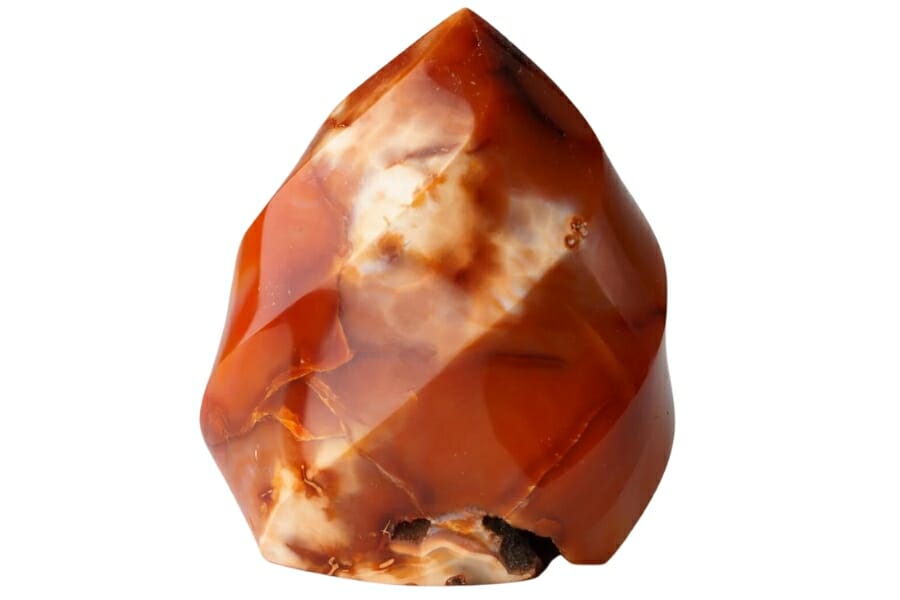
After giving the best recommendations on where the best agates are in Alabama, we’ll give you some more ideas. We put them in order by county to make it easier for you to find them.
Our recommendations by county
| County | Location |
| Blount | Blountsville prospecting pits and gravel pits |
| Blount | Holly Pond |
| Clarke | Tallahatta Formation |
| Clarke | Jacobs Mountain |
Additional areas you can find agates
We want to ensure you have a successful search because Alabama is a big state. Here are some specific places where agates are often found.
Fresh rock exposures
Agate collectors can find agates in fresh rock exposures because these exposures give you a unique chance to get to rocks that have just been exposed or weathered. This allows you to find agates that haven’t been picked over or covered up by nature yet.
The new surfaces reveal new layers of rock that haven’t been worn away or covered up yet, which makes it more likely that agates will be found in them. Agates are often formed within cavities and fractures in rocks, and fresh exposures provide a window into these structures.
Rivers and riverbanks
Rivers’ constant movement works like a natural sorting system, moving and depositing agates and other stones of different densities. Over time, the currents of a river carry agates downstream, where they end up along the riverbanks or in gravel bars.
Rivers wear away at the rocks, revealing new surfaces and layers that could contain agate. Riverbanks are often constantly being worn away, revealing new sedimentary or volcanic rock layers.
Streams and creeks
These waterways are natural ways for agates to get from where they were found to where they are now. Agates can be moved by the flow of water away from the rocks they are attached to.
As streams and creeks flow through different rock types, they pick up agates and other stones and leave them behind for collectors to find.
Streams and creeks are smaller than rivers, so collectors can search areas that are easier to handle. Due to the smaller size of these waterways, agates tend to be found in a narrower area than in larger rivers.
Common Agate-Hunting Questions
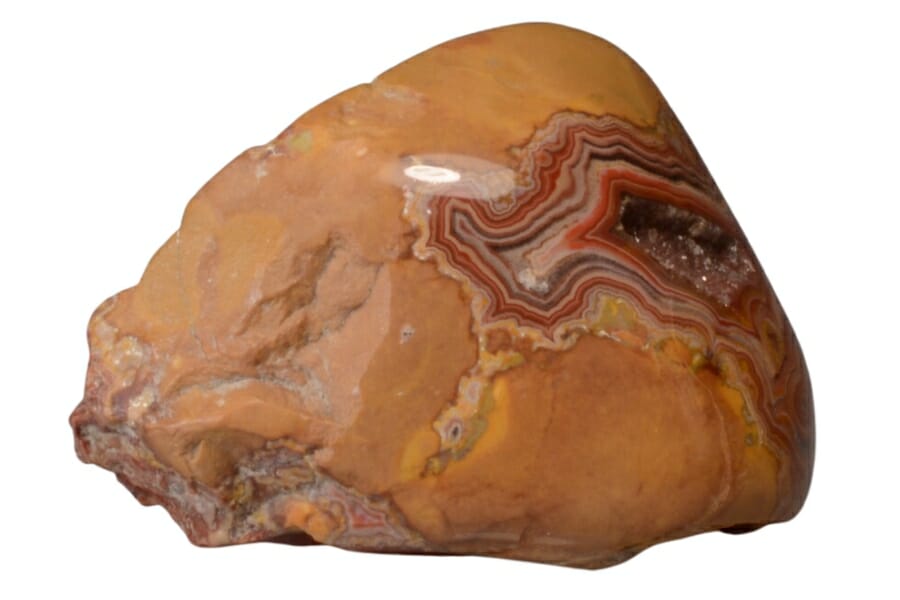
People often ask the questions below about agates in Alabama, and it’s very important to know the answers.
Is it illegal to collect agate in Alabama?
If you do it correctly, Alabama is an excellent place to look for agates. It’s best to follow the rules when you’re in a public place. Make sure you have permission to go on private land before you do.
The Best Places To Buy Agates In Alabama

Not everyone likes to spend the whole day outside looking for agates. Sometimes all you need is a display or another pretty piece of agate to add to your collection. Here is a list of places in Alabama where you can buy agate crystals:
- The Brewer’s Alley – Bldg B, 1905 Main St Ste A, Daphne, AL 36526
- Crystal Corner – 317 Billy B Dyar Blvd, Boaz, AL 35957
- Earthforged Rock Shop – 429 Shields Rd, Huntsville, AL 35811
- Practical Magick AL – 1508 6th Ave SE, Decatur, AL 35601
- Wolf & Mercantile – 146 W Main St B, Prattville, AL 36067
If you have any recommendations for our list please leave a comment below!




